Beetham, Isabella, Mrs (McKechnie Section 3)
See also Sections One, Two, Four, Five and Six
Recorded by Jackson (The History of Silhouettes) and other writers on silhouettes. Recent research has revealed even more material, derived largely from wills and from the contemporary poor rate books for the addresses at which Mrs Beetham is known to have worked. Further information is contained in a MS in the library of the Victoria and Albert Museum, London. Entitled 'Mrs Beetham, Silhouettist', it is by the late Dr F. Beetham, a descendant of the artist.
The artist was born Isabella Robinson. The year of her birth has been given by different authorities as 1752, 1753 or 1754. She came from a north country family of Jacobites and Roman Catholics. Her father was John Robinson, of Sedgefield, Durham, and his father (also named John Robinson), of Lancaster, was a builder and architect, described as 'joiner' on a list of non-jurors issued in 1715. Isabella's grand-father married Elizabeth Snape, daughter of Andrew Snape of Forton, and of Moorhead in Over Wyersdale, and his wife Margaret (née Parkinson). Margaret's father was Christopher Parkinson of Blindhurst. Dr Beetham took these records from such sources as The names of Catholics, Non-jurors, and others, who refus'd to take the Oaths of allegiance to his Late Majesty King George (London, 1745) and similar records of the Catholic citizens of the country made during early Hanoverian times. Isabella is said to have received a small annuity from the Forton estates.
Little is known of her life before 1772 or early 1773, when she met and married Edward Betham (as his name was originally spelt), a lively and versatile man whose career was closely linked with her own.
The first recorded member of Edward's family Ralph Betham, is listed in the Lancashire Assize Rolls 30/31 Hen: III M. 12/1244/45, in which there is a record of a lawsuit being brought by Ralph against his son. In the time of Henry II he owned the manor of Betham, which was still owned by descendants during the reign of Edward III. There were many male descendants of the Betham family; one branch moved to the Border country, where the village of Beetham, about eight miles from Kendal, testifies to their presence in the region. Other descendants moved south. By the reign of James I the Bethams of the Fells owned substantial property at Thrimby, Towcett, Newby and Little Strickland. By 1745, three branches of the family still lived at Towcett, Burton and Little Strickland. Edward Betham and his younger brother William were born at the Long House Little Strickland: Edward in 1744; William in 1749. There were sisters as well. Edward was the eldest of the family. Bethams continued to live at Thrimby, Westmoreland, until 1898.
By the time of his marriage to Isabella (who was at least ten years younger than himself) Edward had outraged his conventional parents by his proposal to become an actor. (At that time ⎯ indeed, until the 1850s ⎯ actors were widely thought to be not only of low social status, but vagabonds and rogues into the bargain). After beginning his theatrical career in a company of strolling players, Edward found employment in London at the Sadler's Wells Theatre, also working intermittently at the Haymarket Theatre, which had been rebuilt in 1767. During this period, he invented a roll-up curtain for the front of the stage, the base being weighted to prevent the constant danger of fire. (Foot-lighting at this time was, of course, still carried out with candles). Although this curtain was widely adopted, Edward made little or no money out of the project, since at the time he could not afford to take out a patent.
Edward's marriage to the daughter of a Roman Catholic with Jacobite sympathies was another cause of estrangement between him and his parents. To avoid embarrassing his parents further, Edward altered his surname by adding a second 'e'; henceforth he, his children and his direct descendants spelt their surname in this way.
The Beethams' first child (a daughter, Jane, later Jane Read, see Section Six) was born in c. 1773. In A House of Letters (London, 1904) a collateral descendent, Ernest Betham, refers to a reconciliation between Edward and his parents on the birth of his second child, William, whose death certificate shows that he was born in 1774. According to a family tree compiled in 1849 by Sir William Betham, Edward's younger brother William was not baptized until 11 February 1778. Earlier in the eighteenth century, when a child was born of parents of mixed faiths it was the custom to baptize a son according to his father's faith, a daughter according to her mother's. Infant mortality at the time was high, and it is possible that William was first baptized in a protestant church in London, and, later, a second time in Westmoreland, if Edward's parents had by then decided to accept their son's wife.
During the infancy of these elder children, the Beetham family lived in London, first in Cow Lane, Clerkenwell, later in Little Queen Street, Holborn. Dr Beetham writes that what is known about this period of their lives is contained in a few letters written by them to a kinswoman, Elizabeth Betham, of Towcett House, near Shap, Westmoreland.
In the theatrical world, Beetham became acquainted with the playwright and actor Samuel Foote, who engaged him at the Haymarket theatre to take part in his 'Primitive Puppet Show', so strongly disapproved of by Dr Johnson. Piety in Pattens was his best known puppet play. Foote's success created a fashion for such entertainments, and the Beethams prepared the busts for two further examples: Stevens' 'Comic Lecture on Heads' and Dodd's Satirical Lecture on Hearts'. In 1775 they produced a 'Lecture' of their own, A New Lecture on Heads, which was shown in London, Norwich, Newcastle (where it was printed) and elsewhere.
If, as has been said, it was Foote who encouraged Isabella Beetham to use her artistic talent professionally, she may have started to cut profiles before 1777, when Foote died. In 1780 the Beethams published a second 'Lecture' (it was printed in Newcastle by T. Robson). The title-page ran as follows: 'Moral Lecture on Heads/By/Edward Beetham /Curious and Serious things are mingled here,/ and more is meant than seems to meet the ear.'
The frontispiece included a portrait of the author in mezzotint (illustrated), decorated with ovals at three of the corners, containing small heads entitled respectively 'Misery', 'Laughter' and 'Gravity'. These heads were signed 'Mrs. Beetham delt.' If, as seems likely, they were engraved from black profiles by Mrs Beetham, then these would be the earliest recorded examples of her work as a profilist. The portrait of Edward Beetham was engraved by J. Jehner after an original by his wife (see John Chaloner-Smith, British Mezzotint Portraits, London, 1884, 4 vols). Dr Beetham possessed a coloured print after a sketch by Rowlandson of a scene from one of these 'Lectures'. He also refers to another portrait of Isabella herself, set in a ring, which she gave to Elizabeth Betham, of Towcett, but we do not know whether this was a silhouette.
1025
At this stage the Beethams were probably still living in Holborn. They then moved to 4 Cornhill,
possibly c. 1783-84. They were certainly there by 8 October 1784, since there exists a cut profile by Mrs Beetham bearing this address and date.
Mrs Beetham was given painting lessons by the miniature painter John Smart; these must have been concluded before 19 April 1785, for John and Anna Smart sailed for India on that date. It seems unlikely that Mrs Beetham produced any painted silhouettes before she received these lessons.
It is possible that by early 1785 the Beethams had received part of the Betham family inheritance, which would have enabled them to afford not only the painting lessons but also the visit which Edward paid to Murano, the island in the lagoon outside Venice where glass is still made, and where Edward wished to learn the art of decorating glass in the verre églomisé style, with a view to framing his wife's work. Another source of income for Edward were the washing machines which he manufactured.
At any rate, the Beethams were now able to afford the premises at 27 Fleet Street, which is well known as the address where they lived and where Mrs Beetham produced silhouettes for many years. The rate books of St Dunstan's Ward contain the following information about the payment of rates for 27 Fleet Street during 1784 and 1785: October 1784, Samuel Taylor; January 1785, house vacant; April 1785, a note that Edward Beetham was to pay for the next quarter; June 1785, Edward Beetham. It is clear from these details that the Beethams moved to 27 Fleet Street in about May 1785. Dr Beetham considered that they took out the lease of No 26 as well as that of No 27. The various activities in which the couple were engaged might well have necessitated the renting of at least part of No 26. It is certain, however, that the family lived at No 27. Their second daughter, Harriet, may have been born by this time.
Ernest Betham (A House of Letters) presents an interesting picture of the area of London in which the Beetham family were then living:
Edward Beetham's first house was near Fleet Street, then rendered picturesque, not only by its many gable-ended houses ornamented with quaint carvings and stamped plaster designs, but also by the countless signs, gilt and painted with strange devices, which hung above the shop and tavern fronts. The Beetham house stood on the west wide of Chancery Lane, within one house of Fleet Street, and commanding an uninterrupted view of that bustling thoroughfare. At that time Fleet Street and Chancery Lane and their neighbourhood was the centre for booksellers, publishers, and engravers, and the residence of the literary, legal, and artistic world. In 1799, the three-gabled house, with its quaintly carved front and picturesque overhanging stories, was pulled down during the widening of Chancery Lane.
Mr Percy Higgs has investigated the positions of the houses at the junction of Chancery Lane and Fleet Street during the late 1790s. His researches, and the entries in the rate books, both indicate that the house described by Ernest Betham was 132 Chancery Lane, which, according to the rate books was (as Betham writes) pulled down in 1799. During the years 1797-99, however, the rates for this house were paid by one Jane Sheffield, whereas Edward Beetham, during these years, paid the rates for 27 Fleet Street. Ernest Betham, therefore, must have been misinformed about Edward Beetham's domicile during these years. The house is again described as 'pulled
down' in the rate books for 1801-05; since there was a plan to widen the entrance of Chancery Lane, rebuilding was out of the question.
The showrooms for Edward Beetham's washing machines (the first to be made with wooden rollers; previously stone rollers had been used) were on the ground floor of 27 Fleet Street. Mrs Beetham's studio was on the first floor.
1026
In his last years Edward Beetham developed a new interest: insurance. Among his many friends was Sir William Rawlins, prominent in the city, an ex-Sheriff, and a member of the Company of Upholders. Sir William founded a new insurance company, the Eagle, which began business on 23 October 1807. At its inauguration, Beetham was elected one of the directors.
Directories yield some information about the Beethams. The Universal British Directory gives an entry for 1790: 'Beetham, Edward, Proprietor of the Patent Washing Machine, Profilist and Publisher, 27, Fleet Street.' (Dr Beetham tells us that in 1787 Edward Beetham published Beetham's Illustrated Edition of Stackhouse's History of the Bible). Kent's Directory contains no mention of the Beethams until 1794, and the last mention of the family is in Lowndes' Directory, 1809. In this year, the rate books tell us, Edward Beetham paid the rates for 27 Fleet Street in January. He died on 18 February at 27 Fleet Street, and was buried at old St Pancras Church. By July the rates were being paid by a Thomas Jenkins.
The Beethams, then, lived at 27 Fleet Street from about 1785 until the spring of 1809. Dr Beetham tells of many famous people whom they entertained during these years: Admiral Bligh and his wife Elizabeth (née Betham); Dr Priestley (whose portrait, copied by the Beethams' daughter Jane from an original by Opie, was wrongly described by Ernest Betham as representing Edward Beetham); George Dyer, the poet; Lidford Bellamy; William Godwin (the writer, who later lived in the Polygon, as did Isabella in later life); John Murray, the founder of the publishing firm, which started business at 32 Fleet Street; John Smart; and many others. Gainsborough painted a small portrait of Mrs Beetham, later destroyed by fire; he made a charcoal sketch of her, however, which survives (it is owned by Sir Edward Beetham, Dr Beetham's son).
Mrs Beetham was busy enough during the mid-1780s to employ assistants. William Gardiner (q.v.) was one of these; Mrs Bull (q.v. below and in Section Two) was probably another. During the early 1790s Mrs Beetham was helped by her eldest daughter Jane. The latest dated silhouette which I have seen was taken in 1799, but a few other silhouettes appear to date from after 1800. Only two advertisements by her are recorded. One (The Times, 6 March 1792) was worded as follows: 'Mrs. Beetham, Profiler, 27, Fleet Street. Likenesses painted on polished glass, in a style entirely new 3s to 3 guineas.' The other advertisement, dating from the same year, is quoted by Coke (Confessions of an Incurable Collector):
PROFILES
Mrs. BEETHAM, who has ever been distinguished as one of the most eminent who ever attempted PROFILE LIKENESSES, continues to execute them with that Taste and Elegance which remains unrivalled. She paints them on Chrystals, ornamented with gold and silver, displaying the hair and drapery in a manner more beautiful than can be conceived till seen: and if not the most striking likeness, no gratuity will be expected. She likewise finishes them on IVORY, COMPOSITION, AND PAPER, for RINGS, LOCKETS, BRACELETS, &c.
Time of Sitting, One Minute
Specimens to be seen at her house, No. 27, Fleet Street.
As there is no mention of 'Miss Beetham' here, it seems that Jane assisted her mother at the studio from some date after 1792 until her marriage in 1797.
On Edward Beetham's death the directors of the Eagle Star Insurance Company presented his widow with a piece of plate and a hundred guineas. As the recent examination of her will disclosed, she then left 27 Fleet Street and eventually lived at 9 The Polygon, Somers Town. The Polygon was a group of houses occupying the centre of Clarendon Square (now between Euston and St Pancras stations). According to Wheatley and Cunningham, London, Past and Present (London, 1891), vol. III, and Palmer's History of St. Pancras, Somers Town was an area which had developed from c. 1786; it was partly rural at this stage, with a scattered population. Because it was largely inhabited by Roman Catholics (among them the Beetham daughters), it became a favourite district for refugees from revolutionary France, who may also have been attracted by the low rents. We know from the rate books that no house in this district was owned by any member of the Beetham family. During the period 1810-25 9 The Polygon was in the hands of a succession of owners, and was sometimes entered in the rate books as empty. There is no evidence that Mrs Beetham continued to paint silhouettes after her husband's death. The area in which she spent her widowhood was neither smart nor prosperous, and she was in indifferent circumstances when she died at 9 The Polygon between 3 and 16 August 1825. The wording of her will, which was proved on 16 August at £200, was as follows:
I do hereby will, bequeath, and devise unto my two daughters, Harriet Norman and Cecilia Georgi, all my property of whatever description, my just debts being paid, to be equally divided between them, their heirs, administrators and assigns, each having an equal moiety: and I do also appoint my above two daughters executrices as witness my hand this third day of August, in the year of our Lord, 1825.
Signed: I Beetham.
Witnessed by: Alex Anderson of 18, Brompton Road.
The will was proved before Justice Addams, Doctor of Laws Surrogate. The Act of Probate, dated 16 August 1825, reads thus: 'On 16.8.25, the Will of ISABELLA BEETHAM, late of No. 9, The Polygon, Somers Town, widow deceased, was proved by the oaths of her daughters, Harriet Norman, and Cecilia Georgi.'
No doubt Mrs Beetham considered that Jane and William (the two eldest of her six children) were already well provided for. Of her two other sons Alfred had certainly, and Charles probably, predeceased her. Her two other daughters, Harriet and Cecilia, may already have been widowed, and living with their mother.
So much inaccurate information about Mrs Beetham's children (about their number, and about them individually) has been published that I should like to present the facts in detail on the basis of recent research.
Mr Percy Higgs has examined all the available wills of the Beetham family. Edward Beetham's will clearly indicates that there were six children of his family, three of whom were under twenty-one at the time of their father's death. He made this will on the day he died (23 January 1809), in the presence of his eldest son William, and two servants, William Howgill and Mary Talbot. The two last named were asked to swear an affadavit to the effect that they were in the room when this will was made, and read to them by William. They swore that Edward Beetham was sound in mind and understanding when he made his will. His property was divided into seven parts: 1. to his wife, Isabella; 2. to his daughter Jane; 3. to his son William; 4. to his daughter Harriet; 5. for his son Charles; 6. for his daughter Cecilia; 7. for his son Alfred.
The first four divisions of the estate were left direct, indicating that the children concerned were all of age. As far as the last three children were concerned, each was to receive his or her inheritance on attainment of the age of twenty-one, the interest in the meantime to be applied to their maintenance and education in equal parts. If any member of the family died, his or her share was to be divided among the surviving members of the family. The Trustees were William Beetham (then living at Bouverie Street), Walter Barnes (of Water Street, Bridewell) and Jane's husband John Read (of Lamb's Conduit Street). The names of the children of the family were obviously given in order of seniority. The will was proved at £3,300 on 18 February 1809.
Harriet, apparently of age when her father died, must have been born by 1788. Since the wording of the will indicates that their education was still incomplete, Charles and Cecilia must have been born later (possibly in the early 1790s). Alfred, the youngest member of the family, made a will in 1816; it might be assumed, therefore, that by this year he was of an age to have received his inheritance, and that he was born possibly c. 1795.
I will conclude this account of the scanty known facts of Mrs Beetham's life, and of the rather fuller available information about her husband and children,with a summary of what we know about these six children (except in the case of Jane, who is discussed in full in the entry on her in Section Six).
Jane. Since we know from his death certificate that William, the second of the Beethams' children, died in 1839 at the age of sixty-five, we can establish the year of his birth as 1774. We can deduce from this that Jane was born c. 1773.
William. Born in 1774, William was a Trustee of his father's will on his father's death in 1809. From family trees owned by Sir Edward Beetham we know that he married one Mary Frost (daughter of James Frost, a merchant), who bore him seven children. He became solicitor and secretary of the Eagle Star Insurance Company founded by his father (The Bath Chronicle of 14 April 1808 contains an advertisement for the company sent in by William from Cornhill). He was also a barrister and Justice of the Peace. He died on 20 September 1839 in Paradise Row, London, at the age of sixty-five, according to his death certificate.
Jane was therefore about thirty-six, William about thirty-five, and Harriet certainly of age, when their father died; three younger children were still minors.
Harriet. We must assume from Edward Beetham's will that Harriet was born before 1788. It is likely that the portrait by Opie illustrated in Ernest Betham's A House of Letters, though stated there to represent Cecilia, in fact represents Harriet. The girl in this portrait, which was probably painted before Jane Beetham's marriage in 1797, looks about fifteen years old (much older than Cecilia would have been at that time) and may indicate that Harriet was born as early as 1780-82. Harriet married one John Norman, and is believed to have had no children. As she was a legatee when her mother died in 1825, she was probably by then a widow.
Charles James. As this son, although he was not yet of age in 1809, was married in 1816, he was probably born 1789-92. The Law Lists for 1819-24 show his name, and it was because he was a lawyer that he and his wife Lydia were appointed by his younger brother Alfred to swear an affadavit which was found with Alfred's will at his death in 1816 (the affadavit states that Charles was a member of the legal profession). He lived at 1 Church Row, Fenchurch Street. He may have died in 1824, since he was not a beneficiary of his mother's will, and his name is not shown in the Law Lists after this year. He cannot have been the Charles James Beetham stated by Ernest Betham (A House of Letters) to have been killed at Quatre Bras in 1814.
Cecilia. Born probably 1793-4, Cecilia married a man named Georgi (not St George, as has often been stated), by whom she is believed to have had children. With Harriet, she was a beneficiary of her mother's will.
Alfred. Since he made a will in 1816 (on 19 September), the Beethams' youngest child must by then have been old enough to be entitled to the inheritance from his father, and therefore was presumably born in c. 1795. He died on 3 March 1819. Though he is described in his will as a surgeon, his name is not included in the registers of the Royal. College of Surgeons, which suggests that he was a medical student at the time of his death. He left all his property to his mother (the will was proved at £100). With this will was the affidavit (referred to above) sworn by Charles and Lydia Beetham. This stated that, some four months before his death, he had told Charles that he had written his will in haste on a small piece of paper, which he had placed in a pocket book, which in turn he had placed in a box of surgical instruments before embarking on a sea voyage. The will was duly found in the box, in Mrs Beetham's presence. It gave his address as 'Chapman Street, in the Parish of St Mary, Islington'. The affidavit seems to have been needed because the will was made in haste and was not witnessed (doubtless because Lydia, then under twenty-one, was too young to act as a witness). It contained the information that Alfred was Charles's natural brother'.
On a pedigree of his family owned by Sir Edward Beetham it is noted that Alfred was a 'favourite pupil of Abernethy'; also, that he died of blood poisoning. (John Abernethy, 1764-1831, was surgeon at St. Bartholomew's Hospital and later Professor of Anatomy and Surgery at the College of Surgeons.)
Mrs Beetham's Work
As far as is known, Mrs Beetham painted silhouettes only in bust-length on glass, and this is convex on all the examples which I have seen. When working on glass, she often painted the silhouettes on a finger-printed base, probably prepared by mixing gum arabic with the pigment. Thumb prints are often visible on such pieces; on silhouettes dating from c. 1785, the thumb prints may be those of William Gardiner (q.v.), whose function was 'to give them the air of figures in shade, rather than the black masses which was customary'. Clever hatching gives these silhouettes both shape and elegance. Usually only the face is left black. Silhouettes taken at 27 Fleet Street (from 1785) show evidence of the use of the needle, though only to indicate the shape of a bandeau or extreme highlighting in the hair. It was hardly ever used to indicate the shape of the sitter's clothing, which was normally drawn with a brush against a finger-printed base. It is unlikely that Mrs Bull (who appears to have assisted Mrs Beetham at 27 Fleet Street
c. 1785-86) painted some of the glass profiles of this date; see entries on her in Section Two (main entry) and in this Section.
Silhouettes dating from c. 1792 onwards are duller in style; many of them are backed with yellowish wax, mixed with some substance intended to give it durability. As a consequence, these later profiles (which are almost circular) have remained in good condition until the present time.
Mrs Beetham's profiles on glass are either terminated with a double-loop concavity (variable within limits) or are in the three-quarter style (the portrait continuing to the base of the oval).
Some silhouettes dating from the early 1790s, backed with the durable wax mentioned above, may be early examples of work by Mrs Beetham's daughter Jane. This possibility is suggested by the fact that Trade Label No. 6 (the only label which gives prices) bears the names both of Mrs Beetham and Jane, and gives a range of prices (2s 6d to 2 guineas) which is lower than those given in the advertisement of 6 March 1792. Mrs Beetham, however, may have lowered her prices during the 1790s because of a decrease in orders, or because her husband (whose activities were now very diverse) had ceased to make his expensive verre églomisé glasses for her profiles.
Some of Mrs Beetham's finest pieces were framed in verre églomisé surrounds (which I have just mentioned), produced by Edward Beetham after his lessons at Murano. These surrounds (referred to in the advertisements as 'gold and silver crystals') are much finer than those produced, for instance, at John Miers' studio. Although all the pieces which I have seen are painted on glass with white (not 'silver') surrounds, it is possible that silver leaf was used for the surrounds of some profiles which I have not seen. The best examples date from the mid- and late 1780s. Mrs Beetham's later work was framed under plain circles of verre églomisé (probably not made by Edward Beetham).
The silhouettes in verre églomisé surrounds are housed in pearwood frames. Some examples are framed under plain convex glass in pearwood. Some early silhouettes painted at 27 Fleet Street (but not in verre églomisé surrounds) were framed in giltwood oval frames, with beading decoration. The back of one extant oval giltwood frame bears a label which shows the fragmentary inscription, 'Chambers, Picture Frame ⎯ Manufactory ⎯ eascod Street'; Chambers may have been the name of the regular supplier of Mrs Beetham's wooden frames. Some later silhouettes, dating from the late 1790s, are housed in papier mâché ovals and plain circular verre églomisé surrounds.
Trade Labels
Of the seven known trade labels Nos 1 - 3 were used for cut silhouettes, Nos 4 - 7 for painted silhouettes.
No. 1, recorded in The Art of Silhouette by Coke (who saw it on the reverse of a cut profile), was used at Clerkenwell or Holborn. Partly reconstructed by him, it reads as follows:
[By ap] plication, leagued with good nat[ural gifts]
[MRS.] BEETHA[M]
[has ena]bled herself to remedy a Dificulty [sic] much
lamen[ted and]
universally experienced, by
PARENTS, LOVERS AND FRIENDS,
The former, assisted by her ART, may see their offspring in any part of the terraqueous Globe;
Nor can Death obliterate the Featuers [sic] from their fond Remembrance.
LOVERS, the POETS have advanced,
'Can waft a Sign from Indus to the Pole.'
She will gratify them with more substantial, though
ideal
[inter]course by placing the beloved Object to their
view.
FRIENDSHIP is truly valuable, was ever held a
Max[im]
They who deny it never tasted its delicious Fruit. or shed a Sympathizing Tear.
⎯ that was so ENDEARING, nay, RAVISHING ⎯
⎯ separations existed ⎯
MRS. BEETHAM will call into B[eing] ⎯
Trade Label No. 2, seen by Mr Graham Thomas on the reverse of a cut silhouette of a child, was also used at Clerkenwell or Holborn. It was printed in script inside an oval border of pearl design, measuring ₇⁄₈ x 1½- ins., and read: 'Mrs Beetham/pinxt./1783'. Trade Label No. 3(illustrated) was used during the early 1780s at 4 Cornhill.
1022.
It has been seen on a silhouette dated 8 October 1784. It reads as follows:
PROFILES
In Miniature
Taken by
MRS. BEETHAM
for Two Shillings and Sixpence each
And a duplicate gratis.
And if not a Striking Likeness no
expence expected.
At NO. 4
CORNHILL, near the Mansion House.
CHILDREN taken equally perfect
Time of Sitting one Minute
NB. Shades of absent or deceased Friends
accurately reduced to any Size, and
dressed in the present Taste.
Trade Labels 4 - 7 were used at 27 Fleet Street. When Mrs Beetham began work there in about May 1785 No. 4 (illustrated) was probably printed for the profiles on paper; No. 5(illustrated), probably for the profiles on glass.
1023, 1024
When stocks of No. 4 were exhausted, before 1790, No. 5 was, I believe, used for all profiles (whether on glass or on paper) of the conventional size. The date 1785, given on Nos 4 and 5, is that of the first printing of the labels.
Trade Label No. 5 reads:
PROFILES
in
Miniature
BY
Mrs. Beetham
No. 27
FLEET STREET
1785.
No. 6, recorded by Jackson (who notes that it was found by the Reverend G. T. Morse on the reverse of a silhouette on glass), was used jointly by Mrs Beetham and her daughter Jane, possibly c. 1797:
PROFILE LIKENESSES
BY
Mrs. and Miss BEETHAM
No. 27 Fleet Street,
LONDON.
Finished in a most beautiful and
slight manner on Crystal, Ivory
and Paper
rime of sitting, One Minute
Price 2s. 6d. to 2 guineas
Old Shades reduced and dressed in the present Fashion
No. 7, which I have not seen, was a small label used, according to previous writers, on such articles as pocket-cases; it bore the address 27 Fleet Street.
IIls 9, 106, 1006-1026, 1216, 1217, 1227
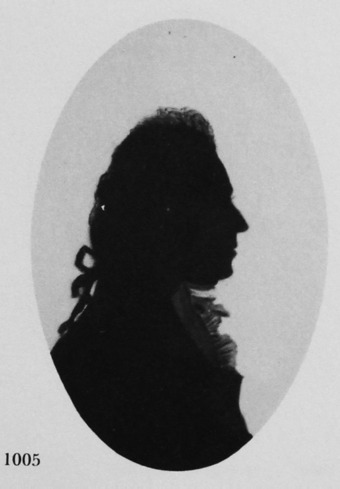
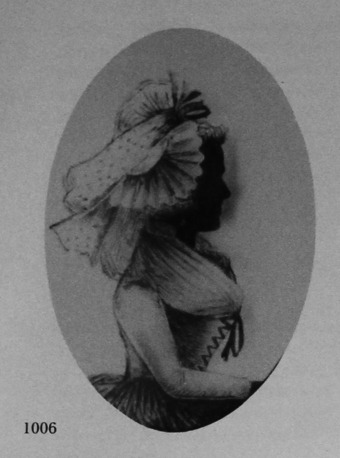
Unknown woman
Silhouette painted on convex glass, with plain verre églomisé border
c. 1785
3¼ x 2¼in./83 x 58mm.
Trade Label No. 5
An especially ethereal silhouette by Mrs Beetham.
T. E. F. Sainsbury collection
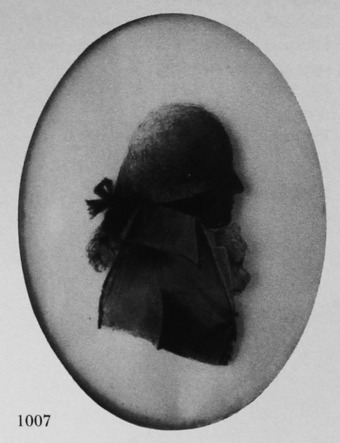
Unknown man
Silhouette painted on convex glass, backed with card
Mid-1780s
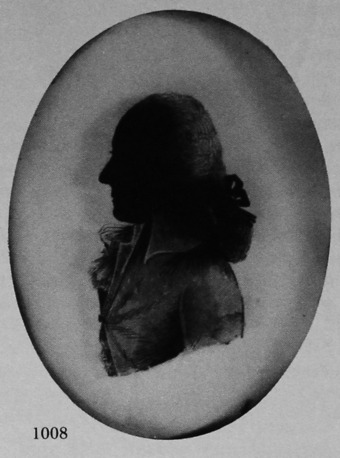
Unknown man
Silhouette painted on convex glass
Mid-1780s
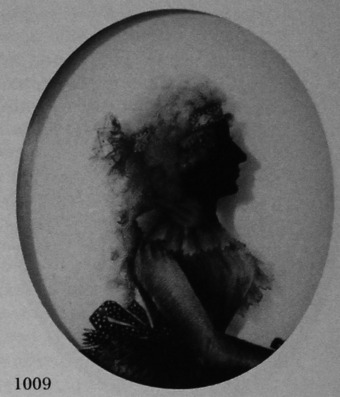
Unknown woman
Silhouette painted on convex glass
c. 1788
3¼ x 2¾in./83 x 70mm.
Frame: pearwood
The bandeau, popular at the time, is finely drawn.
J. A. Pollak collection
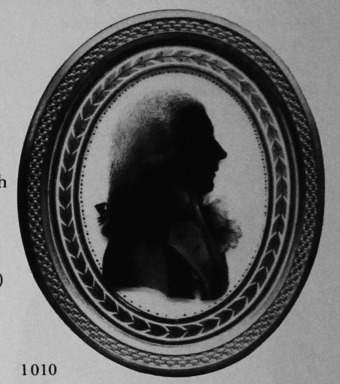
Unknown man
Silhouette painted on convex glass with decorative border
c. 1786-88
3¼ x 2¼in./83 x 58mm.
The probable date is suggested by the size of the sitter’s buttons and the wide, angular lapels of his double-breasted frock. The silhouette has been reframed.
Crown Copyright. Victoria and Albert Museum, No. P137-1922
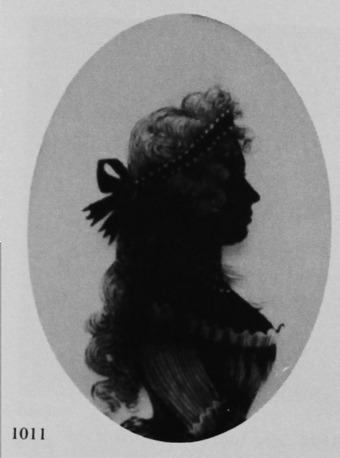
Unknown woman
Silhouette painted on convex glass, with plain verre églomisé border
c. 1788
3¼ x 2¼in./83 x 58mm.
Trade Label No. 5
Frame: pearwood
Miss D. Hare collection
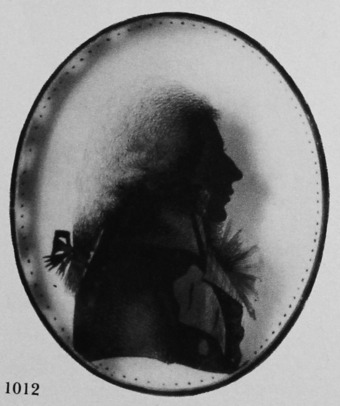
Unknown man
Silhouette painted on convex glass, with verre églomisé border, backed with a plaster slab
1780s
3¼ x 3in./83 x 77mm.
Trade Label No. 5
Frame: pearwood
The verre églomisé is by Edward Beetham.
M. A. H. Christie collection
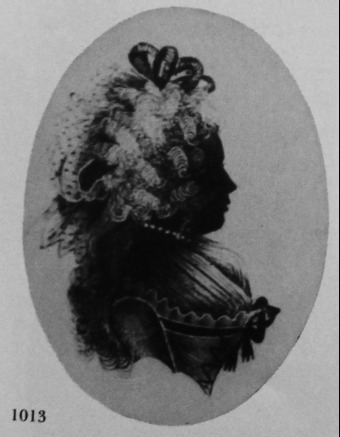
Unknown woman
Silhouette painted on convex glass, with verre églomisé border
c. 1788-90
The sitter’s powdered hair is indicated by the scratching-out of pigment.
From Weymer Mills, ‘One Hundred Silhouettes from the Wellesley Collection’ (1912) by courtesy of the Oxford University Press
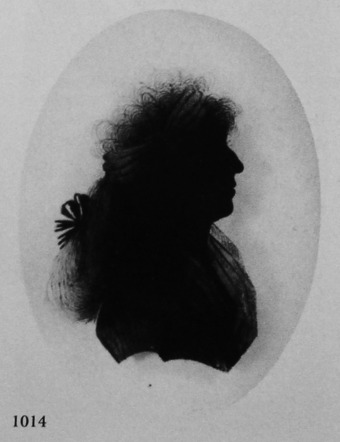
Mrs Sophia Metcalfe, née Andrews
Silhouette painted on convex glass
c. 1792-93
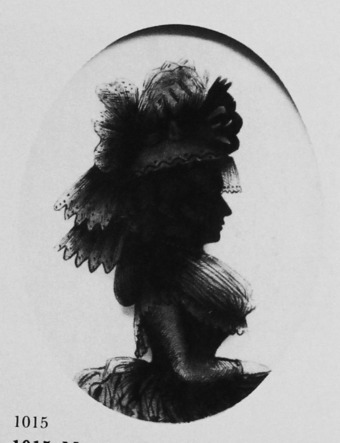
Unknown woman
Silhouette painted on convex glass
c. 1793-94
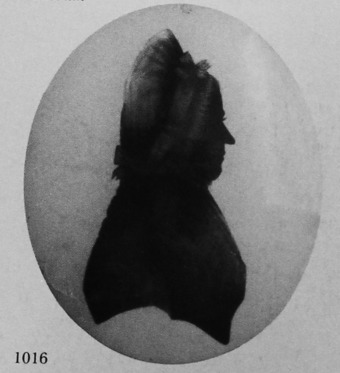
Unknown woman
Silhouette painted on convex glass, with plain verre églomisé border, backed with wax
c. 1798
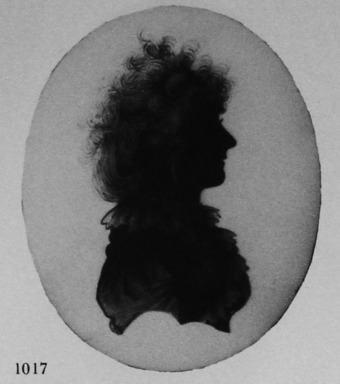
Unknown woman
Silhouette painted on convex glass with verre églomisé border; backed with yellowish was
c. 1795-96
3¼ x 3in./83 x 77mm.
Trade Label No. 5
Frame: pearwood
The detail is finely painted. Edward Beetham was no doubt responsible for the verre églomisé.
M. A. H. Christie collection
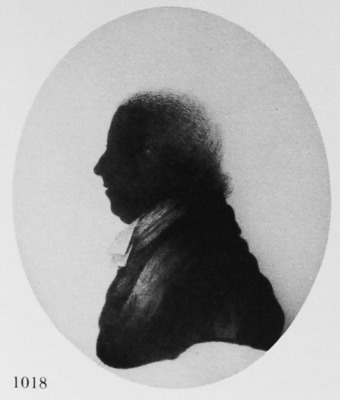
Unknown cleric
Silhouette painted on convex glass, with plain line verre églomisé border; backed with yellowish wax
? Mid-1790s
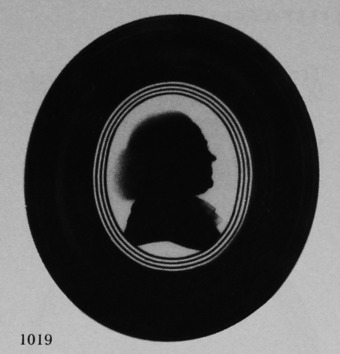
Dr Randall
Silhouette painted on convex glass, with plain line verre églomisé border
c. 1796-98
3 1/8 x 3in./80 x 77mm.
Trade Label No. 5
Frame: pearwood
Typical, both in style of painting and in style of framing, of Mrs Beetham’s later work at 27 Fleet Street. The sitter was a professor of music.
By courtesy of Sotheby Parke Bernet and Company, London
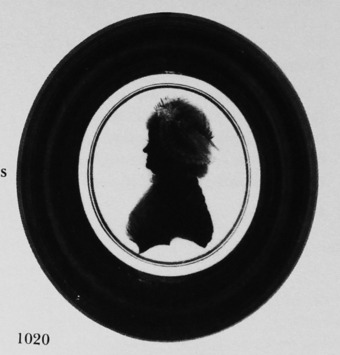
Mrs Mayer
Silhouette painted on convex glass, with plain verre églomisé border
c. 1796-98
Diameter: 3¾in./96mm.
Trade Label No. 5
Frame: pearwood
The sitter was the mother of Mrs Randall, of Southampton: probably the mother-in-law of Dr Randall (1019).
By courtesy of Sotheby Parke Bernet and Company, London
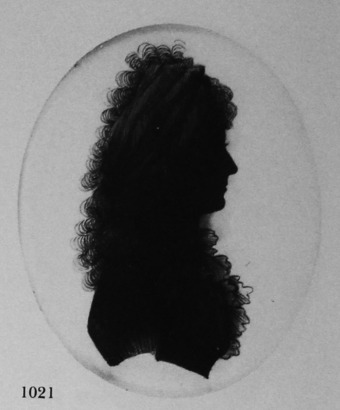
Mary Ann Jones
Silhouette painted on convex glass, with plain line verre églomisé border
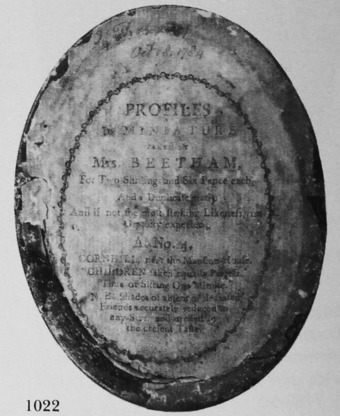
Trade Label No. 3 of Mrs Isabella Beetham.
Author’s collection
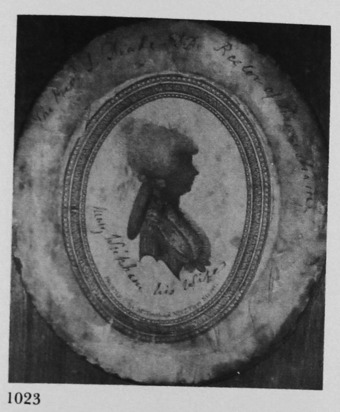
Trade Label No. 4 of Mrs Isabella Beetham, from a silhouette painted on paper
From the collection of the late J. C. Woodiwiss
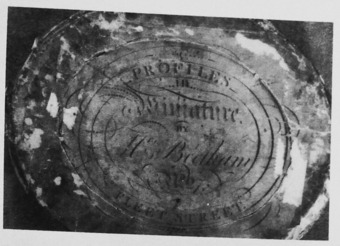
Trade Label No. 5 of Mrs Isabella Beetham.
Author’s collection
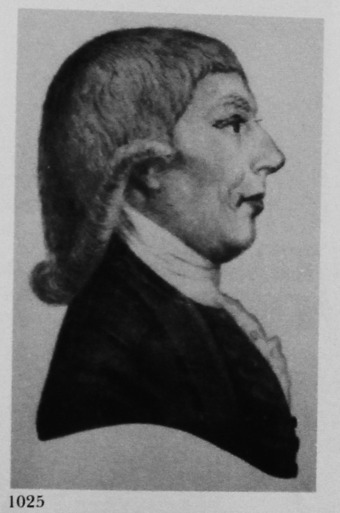
Edward Beetham
Mezzotint engraving, after a sketch by Mrs Beetham
Date of sketch: c. 1778-79
This portrait was produced of Edward Beetham’s Moral Lecture on Heads, printed in Newcastle by T. Robson.
British Museum, Department of Prints and Drawings
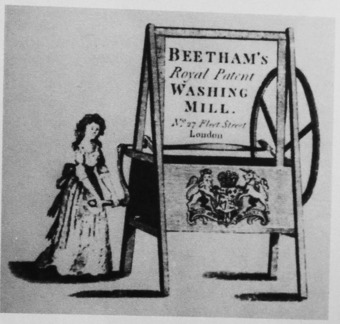
Advertisement (c. 1788-90) for Edward Beetham’s washing machines, probably based on an original drawing by Mrs Isabella Beetham.
From I. C: Woodiwiss, ‘The Ingenius Beetham Family’, by courtesy of ‘Country Life’
DETAIL

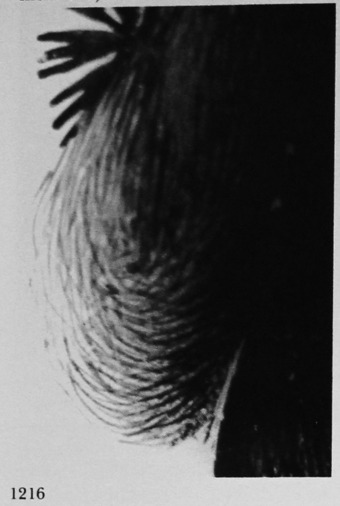
Back of woman’s hair.
Detail from a silhouette by Mrs Isabella Beetham. The artist has not used a needle. (1014)
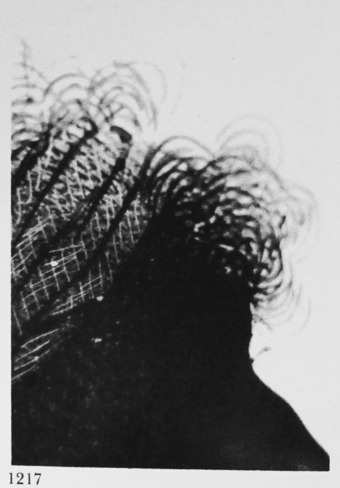
Front of a woman’s hair.
Detail from a silhouette of a woman by Mrs Isabella Beetham. The artist has used a needle to indicate the pattern on the bandeau. (1014)
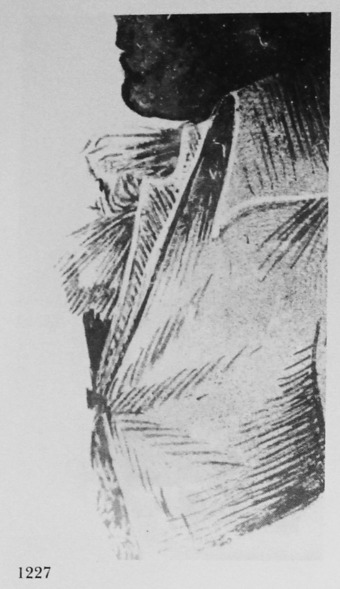
Shirt-frill.
Detail from a silhouette of a man by Mrs Isabella Beetham, showing a typical example of the artist’s treatment of a shirt-frill. The main part of the silhouette is painted against a fingerprinted base; the outline of the sitter’s clothing is rendered by hatching across this base. (1008)
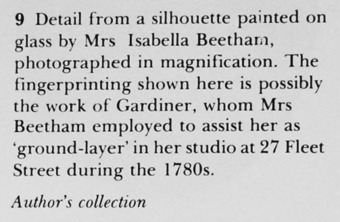
3¼ x 3in./83 x 77mm.
Trade Label No. 5
Frame: papier mâché, with pearwood oval
The reverse bears an inscription: ‘Mary Anne Jones, daughter of Val Jones first married Mr. Harrison a lawyer living in Dublin; a beautiful portrait of her belongs to Misses Bruce, The Farm, Belfast.’
Ulster Museum, Belfast; No. 546-1926
